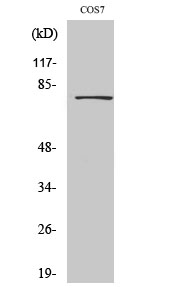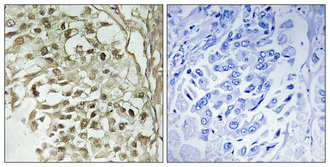Dbf4 Polyclonal Antibody
- Catalog No.:YT1295
- Applications:WB;IHC;IF;ELISA
- Reactivity:Human;Mouse;Monkey
- Target:
- Dbf4
- Fields:
- >>Cell cycle
- Gene Name:
- DBF4
- Protein Name:
- Protein DBF4 homolog A
- Human Gene Id:
- 10926
- Human Swiss Prot No:
- Q9UBU7
- Mouse Gene Id:
- 27214
- Mouse Swiss Prot No:
- Q9QZ41
- Immunogen:
- The antiserum was produced against synthesized peptide derived from human DBF4. AA range:10-59
- Specificity:
- Dbf4 Polyclonal Antibody detects endogenous levels of Dbf4 protein.
- Formulation:
- Liquid in PBS containing 50% glycerol, 0.5% BSA and 0.02% sodium azide.
- Source:
- Polyclonal, Rabbit,IgG
- Dilution:
- WB 1:500 - 1:2000. IHC 1:100 - 1:300. ELISA: 1:10000.. IF 1:50-200
- Purification:
- The antibody was affinity-purified from rabbit antiserum by affinity-chromatography using epitope-specific immunogen.
- Concentration:
- 1 mg/ml
- Storage Stability:
- -15°C to -25°C/1 year(Do not lower than -25°C)
- Other Name:
- DBF4;ASK;DBF4A;ZDBF1;Protein DBF4 homolog A;Activator of S phase kinase;Chiffon homolog A;DBF4-type zinc finger-containing protein 1
- Observed Band(KD):
- 77kD
- Background:
- function:Regulatory subunit for CDC7 which activates its kinase activity thereby playing a central role in DNA replication and cell proliferation. Required for progression of S phase. The complex CDC7-DBF4A selectively phosphorylates MCM2 subunit at 'Ser-40' and 'Ser-53' and then is involved in regulating the initiation of DNA replication during cell cycle.,induction:Induced in G1 phase at low level, increased during G1-S phase and remain high during S and G2-M phase.,PTM:Phosphorylated upon DNA damage, probably by ATM or ATR.,similarity:Contains 1 DBF4-type zinc finger.,similarity:Contains 2 BRCT domains.,subunit:Forms a complex with CDC7. Note that CDC7 forms distinct complex either with DBF4A or DBF4B. Such complexes are stable upon replication stress. Interacts with MEN1, MCM2, ORC2L, ORC4L and ORC6L.,tissue specificity:Highly expressed in testis and thymus. Expressed also in most cancer cells lines.,
- Function:
- function:Regulatory subunit for CDC7 which activates its kinase activity thereby playing a central role in DNA replication and cell proliferation. Required for progression of S phase. The complex CDC7-DBF4A selectively phosphorylates MCM2 subunit at 'Ser-40' and 'Ser-53' and then is involved in regulating the initiation of DNA replication during cell cycle.,induction:Induced in G1 phase at low level, increased during G1-S phase and remain high during S and G2-M phase.,PTM:Phosphorylated upon DNA damage, probably by ATM or ATR.,similarity:Contains 1 DBF4-type zinc finger.,similarity:Contains 2 BRCT domains.,subunit:Forms a complex with CDC7. Note that CDC7 forms distinct complex either with DBF4A or DBF4B. Such complexes are stable upon replication stress. Interacts with MEN1, MCM2, ORC2L, ORC4L and ORC6L.,tissue specificity:Highly expressed in testis and thymus. Expressed also in most ca
- Subcellular Location:
- Nucleus .
- Expression:
- Highly expressed in testis and thymus. Expressed also in most cancer cells lines.
The prognostic significance and potential mechanism of DBF4 zinc finger in hepatocellular carcinoma Scientific Reports Wu Zhongkai IHC,WB Human 1:100 Hepatocellular carcinoma (HCC) tissue HLF cell,SMMC-7721 cell
- June 19-2018
- WESTERN IMMUNOBLOTTING PROTOCOL
- June 19-2018
- IMMUNOHISTOCHEMISTRY-PARAFFIN PROTOCOL
- June 19-2018
- IMMUNOFLUORESCENCE PROTOCOL
- September 08-2020
- FLOW-CYTOMEYRT-PROTOCOL
- May 20-2022
- Cell-Based ELISA│解您多样本WB检测之困扰
- July 13-2018
- CELL-BASED-ELISA-PROTOCOL-FOR-ACETYL-PROTEIN
- July 13-2018
- CELL-BASED-ELISA-PROTOCOL-FOR-PHOSPHO-PROTEIN
- July 13-2018
- Antibody-FAQs
- Products Images

- Western Blot analysis of various cells using Dbf4 Polyclonal Antibody cells nucleus extracted by Minute TM Cytoplasmic and Nuclear Fractionation kit (SC-003,Inventbiotech,MN,USA).

- Immunohistochemical analysis of paraffin-embedded Human breast cancer. Antibody was diluted at 1:100(4° overnight). High-pressure and temperature Tris-EDTA,pH8.0 was used for antigen retrieval. Negetive contrl (right) obtaned from antibody was pre-absorbed by immunogen peptide.

- Western blot analysis of lysates from NIH/3T3 cells, treated with H2O2 100uM 30', COS7 treated with PMA 125ng/ml 30',using DBF4 Antibody. The lane on the right is blocked with the synthesized peptide.



